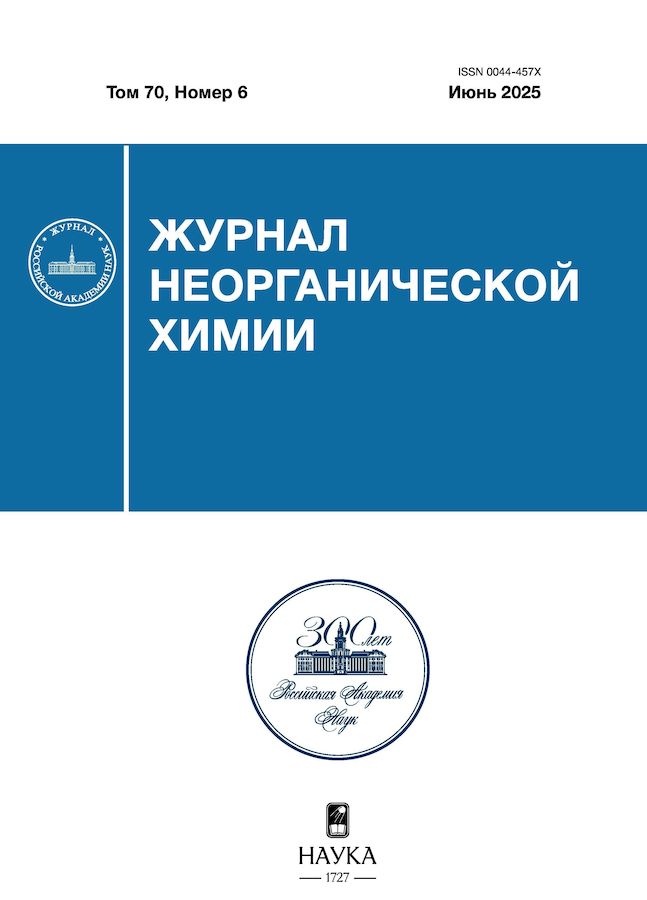The Study of the Formation of Solid Solutions of Lithium in Iridium
- 作者: Lozanov V.V.1,2, Golosov M.A.1, Valyaev D.V.1,2, Nikiforov Y.A.1, Utkin A.V.1,2, Baklanova N.I.1
-
隶属关系:
- Institute of Solid State Chemistry and Mechanochemistry of the Siberian Branch of the Russian Academy of Sciences
- Novosibirsk State University
- 期: 卷 70, 编号 6 (2025)
- 页面: 784-791
- 栏目: СИНТЕЗ И СВОЙСТВА НЕОРГАНИЧЕСКИХ СОЕДИНЕНИЙ
- URL: https://ta-journal.ru/0044-457X/article/view/686364
- DOI: https://doi.org/10.31857/S0044457X25060065
- EDN: https://elibrary.ru/IBTIOI
- ID: 686364
如何引用文章
详细
The interaction in the Li-Ir system using Li3N as a lithium source was studied depending on the temperature, heat treatment time and total pressure in the system. Using X-ray phase analysis (XRD), it was shown that heat treatment of a powder mixture of Li3N and Ir in a graphite or BN crucible in the temperature range of 800–1200°C leads to the formation of a substitution solid solution of Ir(Li), with the lithium content decreasing with increasing temperature, heat treatment time and decreasing total pressure in the system. The maximum lithium content in iridium reached 6.2% at. It was shown that the use of a closed BN container increases the yield of the Ir(Li) solid solution. The use of graphite or BN crucibles prevents the formation of intermetallic compounds of the Li-Ir system.
全文:
作者简介
V. Lozanov
Institute of Solid State Chemistry and Mechanochemistry of the Siberian Branch of the Russian Academy of Sciences; Novosibirsk State University
编辑信件的主要联系方式.
Email: lozanov.25@yandex.ru
俄罗斯联邦, 18, Kutateladze St., Novosibirsk, 630090; 1, Pirogov St., Novosibirsk, 630090
M. Golosov
Institute of Solid State Chemistry and Mechanochemistry of the Siberian Branch of the Russian Academy of Sciences
Email: lozanov.25@yandex.ru
俄罗斯联邦, 18, Kutateladze St., Novosibirsk, 630090
D. Valyaev
Institute of Solid State Chemistry and Mechanochemistry of the Siberian Branch of the Russian Academy of Sciences; Novosibirsk State University
Email: lozanov.25@yandex.ru
俄罗斯联邦, 18, Kutateladze St., Novosibirsk, 630090; 1, Pirogov St., Novosibirsk, 630090
Ya. Nikiforov
Institute of Solid State Chemistry and Mechanochemistry of the Siberian Branch of the Russian Academy of Sciences
Email: lozanov.25@yandex.ru
俄罗斯联邦, 18, Kutateladze St., Novosibirsk, 630090
A. Utkin
Institute of Solid State Chemistry and Mechanochemistry of the Siberian Branch of the Russian Academy of Sciences; Novosibirsk State University
Email: lozanov.25@yandex.ru
俄罗斯联邦, 18, Kutateladze St., Novosibirsk, 630090; 1, Pirogov St., Novosibirsk, 630090
N. Baklanova
Institute of Solid State Chemistry and Mechanochemistry of the Siberian Branch of the Russian Academy of Sciences
Email: lozanov.25@yandex.ru
俄罗斯联邦, 18, Kutateladze St., Novosibirsk, 630090
参考
- Abdou M.A., Team T.A., Ying A. et al. // Fusion Eng. Des. 2001. V. 54. P. 181. https://doi.org/10.1016/S0920-3796(00)00433-6
- Vertkov A.V., Zharkov M.Yu., Lyublinskii I.E. et al. // Plasma Phys. Rep. 2021. V. 47. P. 1245. https://doi.org/10.1134/S1063780X21110258
- Magee C.B. A study of the synthesis and properties of transition-metal hydryls / Final Summary Report, University of Denver, Denver, Colorado, USA, 1964. https://doi.org/10.2172/4675637
- Varma S.K., Chang F.C., Magee C.B. // J. Less Common Met. 1978. V. 60. P. P47. https://doi.org/10.1016/0022-5088(78)90189-3
- Donkersloot H.C., Van Vucht J.H.N. // J. Less Common Met. 1976. V. 50. P. 279. https://doi.org/10.1016/0022-5088(76)90167-3
- Loebich O., Raub Ch.J. // Platinum Met. Rev. 1981. V. 25. P. 113. https://doi.org/10.1595/003214081X253113120
- Zhang J., Hu Y.H. // Top. Catal. 2015. V. 58. P. 386. https://doi.org/10.1007/s11244-015-0379-8
- Duan L., Liu Q., Li Y. et al. // J. Phys. Chem. C. 2009. V. 113. P. 13386. https://doi.org/10.1021/jp901510j
- Yonco R.M., Veleckis E., Maroni V.A. // J. Nucl. Mater. 1975. V. 57. P. 317. https://doi.org/10.1016/0022-3115(75)90216-0
- Holleck H. Binäre und ternäre Carbide und Nitride der Übergangsmetalle und ihre Phasenbeziehungen / Habilitationsschrift, Institut für Material- und Festkörperforschung, Kernforschungszentrum Karlsruhe, Germany, 1981. https://publikationen.bibliothek.kit.edu/200015609
- Банных Д.А., Голосов М.А., Лозанов В.В. и др. // Неорган. материалы. 2021. Т. 57. № 9. С. 925. https://doi.org/10.31857/S0002337X21090025
- Казенас Е.К., Цветков Ю.В. Испарение карбидов / М.: КРАСАНД, 2017. 800 с.
- Kim J., Yamasue E., Ichitsubo T. et al. // J. Electroanal. Chem. 2017. V. 799. P. 263. https://doi.org/10.1016/j.jelechem.2017.06.017
- Kim J., Yamasue E., Okumura H. et al. // J. Alloys Compd. 2017. V. 707. P. 172. https://doi.org/10.1016/j.jallcom.2017.01.050
- Rybin V., Lozanov V., Utkin A. et al. // J. Alloys Compd. 2019. V. 775. P. 503. https://doi.org/10.1016/j.jallcom.2018.10.118
- Rabenau A., Schulz H. // J. Less Common Met. 1976. V. 50. P. 155. https://doi.org/10.1016/0022-5088(76)90263-0
- Pepinsky R. // Z. Kristallogr. – Cryst. Mater. 1940. V. 102. P. 119. https://doi.org/10.1524/zkri.1940.102.1.119
- Cordero B., Gómez V., Platero-Prats A.E. et al. // Dalton Trans. 2008. P. 2832. https://doi.org/10.1039/b801115j
- Даркен Л.С., Гурри Р.В. Физическая химия металлов / Пер. с англ. под ред. Сироты Н.Н., М.: Металлургиздат, 1960. 582 с.
- Ding Z., Qiu L., Li Y. et al. // Mater. Lett. 2013. V. 107. P. 382. https://doi.org/10.1016/j.matlet.2013.06.037
- Lozanov V.V., Baklanova N.I., Bulina N.V. et al. // ACS Appl. Mater. Interfaces. 2018. V. 10. P. 13062. https://doi.org/10.1021/acsami.8b01418
- Yamane H., Kikkawa S., Koizumi M. // J. Solid State Chem. 1987. V. 71. P. 1. https://doi.org/10.1016/0022-4596(87)90135-6
- Cenzual K., Gelato L.M., Penzo M. et al. // Acta Crystallogr., Sect. B: Struct. Sci. 1991. V. 47. P. 433. https://doi.org/10.1107/S0108768191000903
- Зюбин А.С., Зюбина Т.С., Добровольский Ю.А. и др. // Журн. неорган. химии. 2016. Т. 61. № 11. С. 1476. https://doi.org/10.7868/S0044457X16110234
- Зюбин А.С., Зюбина Т.С., Добровольский Ю.А. и др. // Журн. неорган. химии. 2017. Т. 62. № 9. С. 1189. https://doi.org/10.7868/S0044457X17090082
补充文件















